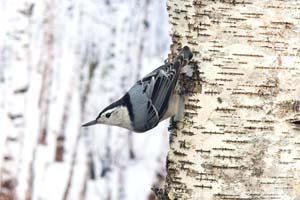 White-breasted Nuthatch
White-breasted Nuthatch
Fun Facts About White-Breasted Nuthatches
- In Central Alberta, the nuthatches we see are Red-breasted and White-breasted Nuthatches. Red-breasted are more common in the city, and White-breasted are seen in rural areas and Edmonton's River Valley.
- The name Nuthatch probably results from the corruption of the word “nuthack” which refers to its’ habit of hacking away at a seed with its beak until it opens.
- When natural food supplies are scarce in northern Canada, numerous species of birds will “irrupt” into a southern migration in search of food.
- White-breasted Nuthatches will often store seeds for retrieval later in the same day or as a quick source of food for the next morning.
- The White-breasted Nuthatch is a common bird of deciduous forests and wooded urban areas. Known as the “upside down” bird, it is often observed creeping headfirst down tree trunks while searching cracks and crevices for insect food.
- A nuthatch’s foot has one big toe (the hallux) that faces backward, while its other three toes face forward. They are able to walk head first down the trunks of trees by moving only one foot at a time while the hallux toe on the other foot holds firmly to the bark.
- Nuthatches are monogamous and defend a territory throughout the year. The female White-breasted Nuthatch rarely strays far from her mate and stays in constant vocal contact when they are more than a few yards apart.
- Male White-breasted Nuthatches are less wary of danger when foraging with their mates than when they are alone. The female mate plays the dominant role as “watchdog” when they are together, leaving the male more time to concentrate on hunting for food.
- The White-breasted Nuthatch is a common visitor to bird feeders. They typically take a single sunflower seed and fly to a nearby tree, then wedge it into the bark and hack it open with repeated blows from their bill.
- In a study of the White-breasted Nuthatch's seed caching behaviour; it was found that they selected unshelled sunflower seeds approximately 25 percent more often than seeds still in the shell. It appears that this preference is driven by the fact that it takes the Nuthatch about half the time to transport and cache an unshelled seed than it does a shelled one.
- During the winter, White-breasted Nuthatches will often forage together with other birds such as chickadees, and Downy Woodpeckers in a group known as a foraging guild. Nuthatches are able to recognize the alarm calls of these species and can thus reduce their own level of alertness by relying on vigilance of these other species. This leaves them with more time to concentrate on finding food.
- White-breasted Nuthatches are bolder and braver when they forage together with chickadees and woodpeckers than when they foraging alone.
- A breading pair may smear insects around their nesting cavity to deter squirrels.
- White-breasted Nuthatches are non-migratory, remaining in their territory year round. They are found in deciduous woodland across North America - from southern Canada to southern Mexico.
- The longevity records for Nuthatches are: White-breasted – 9 years, 10 months; Red-breasted – 7.5 years; Brown-headed – 5 years, 9 months; Pygmy – 8 years, 2 months.

